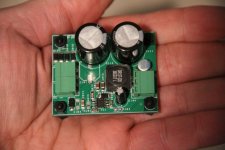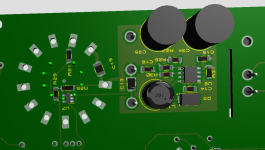Certainly way overkill and heaven only knows what it will do to the poor transformer not to mention the splatter from the huge but short charging current peaks. With a 1.2A load that will have about 170mV peak to peak ripple. No need for it to be that low if you are then going to regulate it. 22000uF would be more than enough giving about half a volt peak to peak ripple.* 66000uF filtering? 😵 😱 You-must-be-joking.
Cheers
Ian
Well it is overdone but again... when the load is low no worries about huge and short charge current peaks. Ripple voltage should be lower than the laws of cheap tell when using an LDO, simple calculations will prove that.
Thanks Gerrit!Hi Jan,
I created them from larger Teflon turrets with a sharp knife. They are actually somewhat longer, but I now prefer my own shorter version.
I found them on Marktplaats, seller “Tauritronics”. I bought quite a few of them a couple of times.
Regards, Gerrit
On getting 6.3VDC from 6.3VAC, have you considered a switching regulator? I've been using a TPS5402 for some time with good results.
Jan
If using DC, you could consider a circuit that swaps polarity every now and again. I believe the tubes prefer this.
Have you just considered a big choke pi-filter rather than a SS regulator? Pretty small drop. Other than that, I would suggest a nice little 9V transformer... Probablly a lot cheaper than a choke.
Have you just considered a big choke pi-filter rather than a SS regulator? Pretty small drop. Other than that, I would suggest a nice little 9V transformer... Probablly a lot cheaper than a choke.
LMR14030 which I already suggested here has better specs. For indirectly heated tubes it does not make much sense to use linear regulators, chokes or other stuff. You can have similar performance with something that fits in your palm and costs less than 20 euros.On getting 6.3VDC from 6.3VAC, have you considered a switching regulator? I've been using a TPS5402 for some time with good results.
Jan
Attachments
Yea, but I spent too many years in failure analysis. Chokes don't fail 🙂 But for everyone else, Jan has spoken.
If you really want to get fancy you can throw in an LT4320 https://www.analog.com/en/products/lt4320.html#product-overview
Much less space too.LMR14030 which I already suggested here has better specs. For indirectly heated tubes it does not make much sense to use linear regulators, chokes or other stuff. You can have similar performance with something that fits in your palm and costs less than 20 euros.
Jan
Attachments
The filament is capacitively coupled to cathode ... the switching noise is visible in audio path . So it is important what filament supply you use .
Contrary to the cheap chinese switchers the switching frequency in these designs is >500kHz. Much easier to filter than 50Hz related noise in other type of filament supplies.The filament is capacitively coupled to cathode ... the switching noise is visible in audio path . So it is important what filament supply you use .
Using the MIC29303 chip there is no need for using a swithing mode regulator. Just use a Schottky bridge, the MIC29303, two resistors and two capacitors. That’s enough! Set and forget!
Regards, Gerrit
Regards, Gerrit
What about mains fluctuations? What is the minimum VAC you need as input to prevent dropping out?
Edit: I can answer that myself. 6.3VDC + 0.5V drop-out = 6.8V rectified.
Take 0.8 for two Schottkys makes 7.6V peak = 5.3VAC. Seems safe enough.
Jan
Edit: I can answer that myself. 6.3VDC + 0.5V drop-out = 6.8V rectified.
Take 0.8 for two Schottkys makes 7.6V peak = 5.3VAC. Seems safe enough.
Jan
Last edited:
Hi Jan,
It will work just fine with a 10% mains voltage drop (with 2 x 1.2A load).
Regards, Gerrit
It will work just fine with a 10% mains voltage drop (with 2 x 1.2A load).
Regards, Gerrit
You forgot the heatsink😉Using the MIC29303 chip there is no need for using a swithing mode regulator. Just use a Schottky bridge, the MIC29303, two resistors and two capacitors. That’s enough! Set and forget!
Regards, Gerrit
Switching regulators are about as simple. You only need to add an inductor, another schottky, 1 resistor and 2 capacitors. No heatsink and much less space.
For a little more than 1 Watt noty a lot of cooling is required. I use two regulators for 2 channels, so that’s just a little over 2 Watts.
And I took care of the power surge for cold heaters.
Regards, Gerrit
And I took care of the power surge for cold heaters.
Regards, Gerrit
I can confirm that the combo of a Schottky bridge with one of the MIC29xyz works very well. I use it in my standard designs if I have a mains transformer which delivers 6.3V. The MIC29xyz come in 1.5, 3,5 and 7.5 Ampère versions which are pin compatible (TO220 and TO247) although the 7,5A version is quite expensive. Just beware of the different lines with fixed/variable voltage and enable/flag outputs.
I also built an active rectifier to use instead of the Schottky diodes using the LM74670 which tested very well and results in a much lower drop than a Schottky diode. But this is overkill in most of the cases and you have to create an SMD board. Just did it for fun.
I also built an active rectifier to use instead of the Schottky diodes using the LM74670 which tested very well and results in a much lower drop than a Schottky diode. But this is overkill in most of the cases and you have to create an SMD board. Just did it for fun.
I think the LT4320 works only with 9V and above. I was looking into it, but then for that reason went for a design with 4 LM74670s.If you really want to get fancy you can throw in an LT4320 https://www.analog.com/en/products/lt4320.html#product-overview
A 6SN7 cold heater at room temperature measures around 2.3 Ohm. The MIC29303 can handle two tubes without any problem or overheating.
Regards, Gerrit
Regards, Gerrit
Yes, I've done some measurements on heater inrush, and mostly after a second or 10, they are close to steady state.
Both switchers and linear regulators will survive that.
Jan
Both switchers and linear regulators will survive that.
Jan
- Home
- Amplifiers
- Tubes / Valves
- Get regulated 6.3 VDC from 6.3VAC

